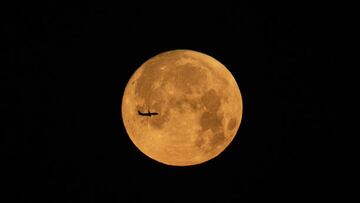Strawberry supermoon: how and when to watch June’s full moon
The June “Strawberry” supermoon is the second of four for the year to be followed by the “Buck Moon” in July and the “Sturgeon Moon” in August.

Following the “Flower” supermoon in May, those who have clear skies will be able to enjoy three more this summer. The next known as the “Strawberry” supermoon will be at its peak of glory on Tuesday 14 June.
Those that go out to view the celestial spectacle may be thinking that they will be treated to a red-hued moon as the name would indicate. However, the name traces its origin to Native Americans who collected the sweet berries that ripen at this time of year. Depending on the atmospheric conditions, except for when the moon is near the horizon, it will likely have a golden color, according to astronomers once it moves into the night sky.
Also see:
When can I see the Strawberry supermoon?
The Strawberry supermoon will appear full from Sunday 12 June through to Wednesday 15 June. It will reach peak luminance on Tuesday 14 June. The moon will rise at 9:15 pm ET in New York, and 8:56 pm PT in Los Angeles, a little less than an hour after sunset.
Where did the “Strawberry Moon” get its name?
The June Strawberry moon got its name from the Native American Algonquin, Ojibwe, Dakota, and Lakota tribes, as it marked the time of year when they began gathering “June-ripened” strawberries according to the Farmer’s Almanac.
Alternative names used by Native American tribes include Blooming Moon (Anishinaabe) which is in reference to the flowering season, while Green Corn Moon (Cherokee) and Hoer Moon (Western Abenaki) indicate that it was time to tend young crops.
The Moon is at its brightest and largest 🌕
— NASA (@NASA) June 13, 2022
Watch the sky at 7:52am ET (11:52 UTC) on June 14 to gaze upon the Strawberry supermoon—when the Moon is both in its full phase and near perigee, or its closest point in orbit around Earth.
Read our Moon guide: https://t.co/K0xnkQwDMc pic.twitter.com/HfbIUAgprR
What is a supermoon?
Supermoons occur when the moon is full at the same time as its closest approach to Earth in its elliptical orbit, or perigee. A full moon is considered a supermoon, not an official astronomical term, when it comes within 90 percent of perigee. They always appear consecutively happening three or four times a year.
According to NASA: “Different publications use slightly different thresholds for deciding when a full moon is close enough to the Earth to qualify as a supermoon.” Because the orbit of the moon is not a perfect circle, the moon is sometimes closer to the Earth than at other times during its orbit. This year some publications are only recognizing two supermoons in 2022, the ones in June and July.
Related stories
The “Buck” supermoon next month on Wednesday 13 July 2022, will be the closest and brightest full supermoon of the year. The final supermoon of 2022 will happen Thursday 11 August, known as the “Sturgeon Moon.”
On average, supermoons appear about 7 percent bigger and about 15 percent brighter than a typical full moon. Compared to the moon at its faintest, a supermoon is roughly 17 percent bigger and 30 percent brighter.


